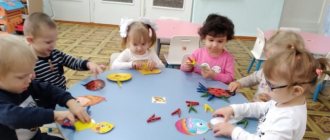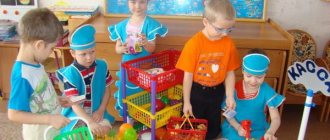The game is a reflection of life. Organization of independent activities during a walk
Ainura Akmatova
The game is a reflection of life. Organization of independent activities during a walk
The process of raising children is continuous. Great potential opportunities for the comprehensive harmonious development of a child’s personality are inherent in the process of educational work with children in a walking .
In order for the pupils to willingly go for a walk , we think through its content in advance, arouse children’s interest in it with the help of toys or a story about what they will do on the site. If walks are meaningful and interesting, children, as a rule, go for walks with great desire. In addition to organized independent activity occupies a large place in the routine of children aged 5-7 years . The child has the opportunity to play and move at his own request. Children themselves choose what to do, while the teacher plays the role of director of children's activities . If at primary preschool age a child cannot yet occupy himself for a long time, therefore independent activity at this age is short-lived, periodic and needs constant direction from a teacher. With age, children's interests change: starting from middle age, children prefer the company of peers. there is more variety in independent activities Everything here is “as if”
,
“make-believe
,” but in this conditional setting, which is created by the child’s imagination, there is a lot of reality: the actions
of the players are always real , their feelings and experiences are genuine and sincere. The child knows that the doll and the bear are just toys, but he loves them as if they were alive, he understands that he is not a “true”
pilot or sailor, but he feels like a brave pilot, a brave sailor who is not afraid of danger and is truly proud of his victory.
Imitating adults in play is associated with the work of the imagination. The child does not copy reality; he combines different impressions of life with personal experience . In the game, all aspects of the child’s personality are formed, a significant change occurs in his psyche, preparing him for the transition to a new, higher stage of development. A special place is occupied by games created by children themselves. In these games , preschoolers reproduce in roles everything that they see around them in the life and activities of adults . Creative play most fully shapes a child’s personality, and therefore is an important means of education. Children's games are varied in their content, the degree of independence of children , forms of organization , and game material. Today I present to your attention one of the walks in spring , when nature and children along with it are just beginning to awaken. Every minute is precious, everyone is busy with their own business. Someone is researching, someone is building, as a result of observing the creativity of children, you begin to understand that the games they play are only the beginning of the threshold of positive, serious things.
Against the backdrop playing independently, the teacher can tell and show them something, communicate with one or two on a topic that interests them, organize individual games and entertainment, and observe with a subgroup of children some unusual phenomenon or event that they themselves have noticed. The main thing is to make sure that you don’t get bored while walking .
Independent activity of children. (indoors, on a walk)
(indoors, on a walk)
Use the time allocated for children’s independent activities rationally. Teach them to keep themselves busy if an adult is busy with a child who needs his help. Help to change the type of activity in time. Ensure the emotional and positive state of children in games and other types of independent activities.
Satisfy children's need for movement: walking, climbing, climbing, throwing, etc. Provide a variety of opportunities to play with balls, rollers, strollers, etc. Use the natural environment: walk along a sandy path, climb hillocks, ladders, etc. etc. (on a walk).
Encourage participation in outdoor games.
Provide the opportunity to independently play with educational toys, small and large building materials, plastic construction sets (such as Lego), using the skills acquired in the classroom. Together with children, build large buildings (a house with a fence, etc.). Use toys of the appropriate size as additional material.
In the summer, play with natural materials while walking. Combine sand games with games with building materials, water games with story games. Teach children to lay out familiar figures depicted by adults in the sand with pebbles, shells, and pine cones. Encourage children to independently include natural material in story games as substitute objects (leaf - plate).
Develop fine motor skills of hands in actions with large tailor buttons, zippers, lacing, etc.
To promote the development of the ability to display familiar life situations in games. Learn to master basic gaming techniques. Children of the first subgroup are taught to perform simple play actions by imitation. Encourage them to independently select objects and toys necessary for play; perform the same play action with different toys.
To promote the display in the game (children over 1 year 6 months) of familiar adult actions. To develop the ability to reproduce two interrelated actions that were previously performed separately (bathe a doll - put it to bed).
Encourage children to use additional gaming material in the game, replacing missing items (kneaded items)
titels). Encourage the use of ribbons, plastic bottles, cups, acorns, cones, and implements (nets, scoops, etc.) in games.
Learn to play without interfering with each other. Develop the ability to ask for toys, exchange them, provide basic assistance to an adult (bring an item needed for the game); with the help of the teacher, distribute actions (one child puts cubes into the car, the other takes them to a construction site, etc.). Cultivate a feeling of sympathy for each other.
Approximate list of outdoor games on site
For the warm season: “Sunny Bunny”, “On a narrow path”, “Jumping frogs”, “Catch up with the bunny”, “Mice”, “Running with rattles”, “Geese-geese”, “Catch a moth”, “Teddy bear” clubfoot”, “Hen with chicks”.
For the cold season: “Roll down the hill”, “Everyone come to me”, “Bunny, go out into the garden”, “The birds have flown”, “Winter fun”, “Horned goat”, “Hide and seek”, “We are white snowflakes”, “Owl-owl”, “Locomotive-steam locomotive”.
Approximate list of basic games and activities for a five-day week
In order to systematically influence the development of children, conduct special games and activities. Teach children to listen to an adult, watch what he does and shows, imitate his words and actions, and complete tasks.
With children of the second year of life, it is recommended to conduct two classes per day: with each subgroup, ten classes per week.
Games-activities with children of the first subgroup are carried out during the second period of wakefulness, with children of the second subgroup - in the morning and evening periods of wakefulness.
With children aged 1 year - 1 year 6 months, games and activities are carried out in groups of 3-5 people. The duration of the lesson is 5-7 minutes. Children aged 1 year 6 months -2 years can be grouped in groups of 8-12 depending on the nature of the activities. The duration of the lesson is no more than 10 minutes.
| Types of activities | Number of classes |
| Orientation Expansion | |
| it surrounding and speech development | |
| Development of movements | 2 | |
| ('about building material | 1 \ |
| C. didactic material | |
| Musical |





